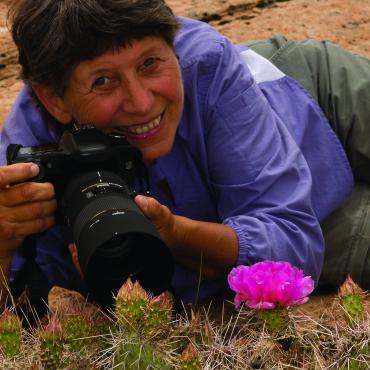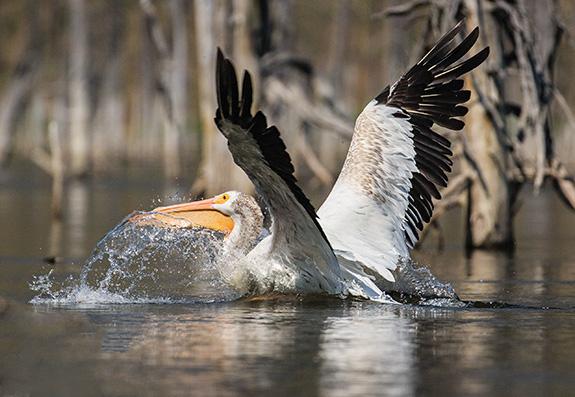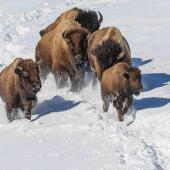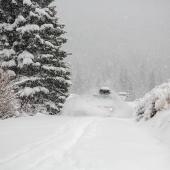Bird Bath
Photographing Quake Lake’s winged citizens.
Early, before the wind came up and disturbed the glass-like surface, I slid my kayak into the lake. I pushed off with snacks, water, and my camera, fitted with a 100-400mm lens; I also carried a 500mm support lens, knowing I would get plenty of bird action. The entire scene was idyllic, yet haunting. I looked to the distant ghost trees standing as erect custodians of the lake. It was those eerie sentinels that I was about to paddle toward and meander through after my “prey,” the varied and exquisite bird life on Quake Lake.
I hung my head low and pulled down the brim of my hat, dimming the glare. My paddle dipped into the water, creating slight ripples. The ghost trees that I moved toward were a reminder of the earth-shattering disaster in August of 1959. Thus, Earthquake Lake was formed.
Before I reached the trees, I practiced my camera steadiness on the fly fishermen anchored among the watery grove. Their lines danced and glimmered, backlit in the still air as the dead trees provided an otherworldly setting. Fish jumped everywhere while the eagles and osprey hovered above, waiting for one opportunistic plunge.
Slowly, I maneuvered my kayak under a roosted raptor, which clutched its steadfast perch with two-inch talons; with piercing gaze it stared at this non-angler below. Rarely does one get so close to these shy birds of prey. Here, they have become so habituated to the fishermen that kayaking under or toward them is rarely a problem. Ruffling its wet feathers and pecking on its prey, the eagle defended itself from hungry crows.
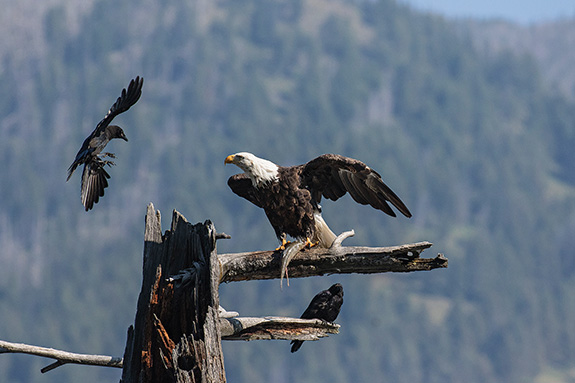
Camera between my knees, I pulled up my paddle and changed my course, as I invaded another part of the lifeless forest. Dead, moss-laden branches lay beneath the murky surface. I lost myself in time and in mysterious solitude as I studied the depths.
The trance was broken by a splash nearby. Webbed feet gained speed along the water and wings flared out. My intrusion had caused quite a stir, and my hands were slow to respond to the cormorant’s speed. Next time, I’ll watch for the cormorant’s take-flight cues, when their heads begin to twitch and their long necks take on peculiar angles.
More piercing green eyes betrayed nervousness at my approach. Cormorants are action-packed once they jump off a low-lying branch. Positioning myself so the light was behind me with my subjects front-lit, I could get the detail in the feathers. Their twitching cues were my signal to balance my paddle and pull up my lens. I rapidly fired away while they ran across the water. The murky, shadowy water broke into gentle waves.
I paddled toward the Madison River inlet. Moving through the shallow water, with tree stumps and lake boulders, was like traveling back in time. Pelicans perched on the rocks, their colored beaks and webbed feet making an orange splash amid the earth tones. As I floated closer, they hopped into the water. As they prepared for take-off, I lifted my equipment, arched my back, and took aim, drifting into a tree with a thump. When they flew over, their nine-foot wingspans fanned the air above me. Mergansers raced across the water with chicks trying to do the same as giant splashes encompassed them. They were swift and equally as difficult to photograph as the cormorants. Getting one sharp image was an accomplishment.


